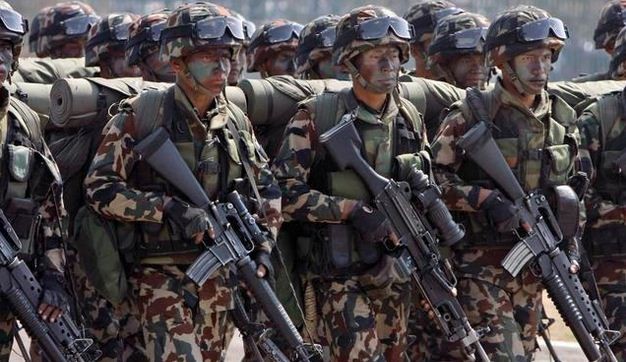Why was Nepal not colonized by the British, like they did to India? This very popular question was asked in popular question-answer platform Quora. Many of us would really want to know the answer.
An anonymous user has responsed to queston in a well manner with fact, details and logic. Here is the answer you are looking for. Why Nepal was not colonized by British: 7 reasons why Nepal was not colonized:

First one needs to analyze the background that lead to the war.
The Anglo-Gurkha war started in 1814 A.D. The British crown took direct control over its South Asian colonies only in 1847 A.D.
So, firstly Nepal didn’t go into a war with the British during the peak of their dominance. In fact, in 1814 the British were just trying to get a foothold in South Asia.
The area under the control of the East India company during 1804 A.D. (just 10 years before Anglo-Gurkha war) is shown in this map:
See how the British didn’t even have 1/3rd of India under their control. Only areas shown in purple were under the rule of East India Company. All areas shown in green color were independent state.
Secondly, Nepal was at the peak of its dominance in South Asia as shown by this map.
Nepal extending from Bhutan in the East to Punjab in the West.
1814 Thomson Map of Northern India and Nepal.
Secondly, unlike suggested in other answers, Economic cause was infact, one of the main reasons for the war.
“The British had made constant efforts to persuade the Nepalese government to allow them their trade to the fabled Tibet through Nepal. Despite a series of delegations headed by William Kirkpatrick (1792), Maulvi Abdul Qader (1795), and later Knox (1801), the Nepalese Durbar refused to budge an inch. “
Nepal, at that time, was the largest exporter of Wool, Tea, Raktachandan, Timber, Medicinal herbs and Copper in whole of South Asia. And Nepali coins were the currency of trade for much of Tibet and some parts of Northern India.
In fact, impurity of the Nepalese coin after the Anglo-Gurkha war was one of the reasons for the second Nepalese–Tibetan War. After the war with Tibet, Nepalese coins in Tibet were replaced by coins from China in 1840.
Furthermore, all the navigable trans-himalyan passages for trade between Tibet or China with South Asian nations lied within Nepalese territories only. This was a great source of irritation for EIC, as their primary purpose in South Asia was to just extend their trade.
((Despite all this, Nepal was never the economic giant that some of the states in India were; but not because Nepal was poor, compared to contemporary nations Nepal wasn’t, but because those states in India, were not just rich in India, they were the richest countries of the world at those times. How many Taj Mahals are there?))
Thirdly, it was not the British that instigated the war. It was the Gurkhas themselves; after Bhimsen Thapa, the ruler of Nepal, started demanding tax from the Nawab of Oudh for the territories of Butwal and Seowraj. The British had to come to the rescue of their protectorate.
Anglo-Nepalese War
The Gurkha Empire at the time was expanding at a rapid rate and was seriously starting to threaten Company’s existence. The expansion of Gurkha Empire can be briefed as:
“The Gorkha army invaded Kumaon Kingdom and occupied it in 1790–91. Then the Gorkha army invaded Garhwal Kingdom and occupied it in 1804 after defeating its King Pradyuman Shah. The southern border of Nepal extended to Allahabad after absorption of Palpa Kingdom, including the Terai sector of Butwal taken by the king of Palpa from the king of Awadh on lease in 1801. In 1806, the Gorkha army absorbed all the small kingdoms like Sirmudh state, Hindur and Besahar lying across the Garhwal and up to Satluj River. In this way, the Gorkhas occupied all the hilly regions such as Nainital, Almora and Dehradun without crossing the Satluj River. However, when the Gorkhas crossed the Satluj river, the Gorkha’s attack on Kangra and siege of Kangra Fort west of Satluj river was repulsed by the Kangra king with help from Maharaja Ranjit Singh of Punjab in 1809.”
The British felt that it had become absolutely necessary to thwart rise of Gurkha Empire so as to ensure that its own interests in South Asia aren’t hurt.
Fourth,
The Anglo-Nepalese War was by no means a small scale war. It was a full blown war between two very well armed and ambitious sides that had a point to prove.
Also, the war didn’t end in weeks or months. It was a prolonged war that extended for 2 full years.
The war occured in two phases aka the First Campaign and the Second Campaign.
The Nepalese side won a resounding victory over the British at the end of the First campaign as the British had seriously underestimated the Gurkha’s military capabilites.
After the First Campaign, by mid-February, of the four British commanders the Nepalese army had faced till that time, Gillespie was dead, Marley had deserted, Wood was harassed into inactivity, and Martindell was practically incapacitated by over-cautiousness. It set the scene for Octorloney to soon show his mettle and change the course of the war.
The British then actually committed more than (or about) 40000 troops to fight against the Gurkha’s.
The Second Campaign was a disaster for Gurkha’s as they lost almost all the wars. They were completely out-stretched by the relentless British and suffered an extremely humiliating defeat that ultimately culminated into the Sugauli Treaty.
Cost of War:
For EIC, the Gurkha War had in reality cost more than the combined cost of the campaigns against the Marathas and the Pindaris for which Lord Moira’s administration is better known: Sicca Rs. 5,156,961 as against Sicca Rs. 3,753,789.
Fifth,
The war was never about annexation of Nepal but was rather about thwarting Nepal’s expansionist tendencies.
After the war, Sikkim regained its independence (note that it was not annexed by the EIC. Sikkim only became part of india in 1975 after annexation by india).
The Chand kings of Kumaon and Garwhal were also given the right to rule their land while they did agree to accept British suzerainty.
Essentially, at the end of the war Nepal lost those territories that it had accumulated within the last 3 decades or so, in the first place.
Sixth,
Topography: Nepal was inconquerable from North during winters ( because it snowed in the mountains) and from South during Summer and monsoon (because of malarial mosquitoes in the Terai).
The British in reality lost more soldiers to illness than at the war.
Seventh,
Before the start of Anglo-Gurkha war in 1814, Nepal actually accepted the suzerainty of Qing Emperor of China in the immediate aftermath of Sino-Nepalese War ( 1788-1792 A.D.)
This was another major reason for E.I. Company’s decision to not annex main Nepalese territories. The British were just in the process of consolidating their power in South Asia.
Annexation of Nepal would had inadvertenly brought them in close confrontation with the Qing Empire, which they tried to avoid at all cost.
This was also the reason why the British left not just Nepal, but Bhutan, Kashmir and Sikkim unconquered as well.
The annexation campaign of the British Raj started only in late 1800’s, once it had fully gained control over much of the indian princely states. but by that time Nepal was already considered to be a British ally, and thus the British felt no need to conquer Nepal.
In fact, relationship between Nepal and the British Raj were so good that “Prime-Minister of Nepal and Maharaja of Kaski & Lamjung, Jung Bahadur Rana was the first Rajah and Prime-Minister to get state honors in the court of Queen Victoria in 1850 A.D.” He was also the first South Asian head of state to visit Europe.





